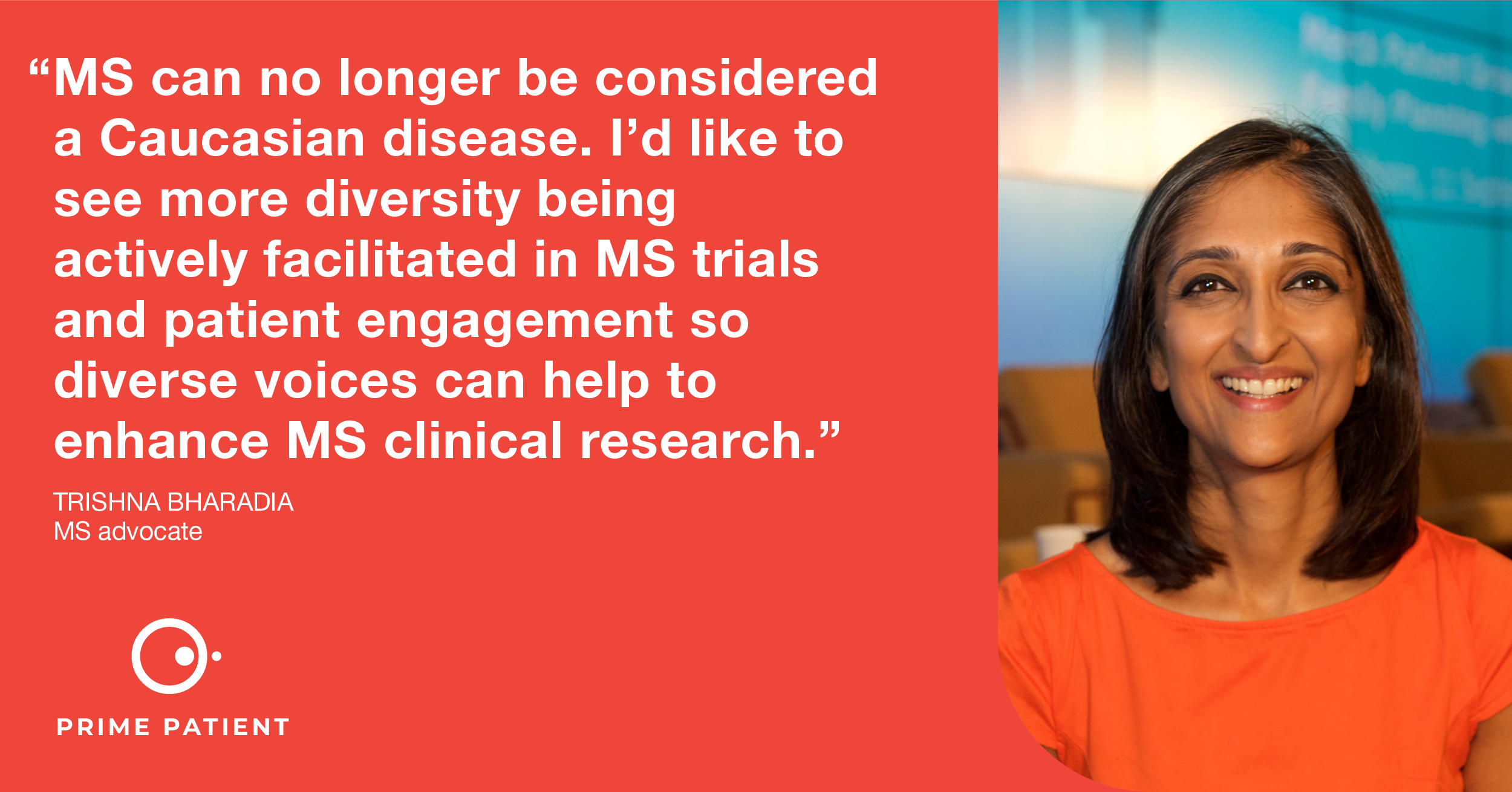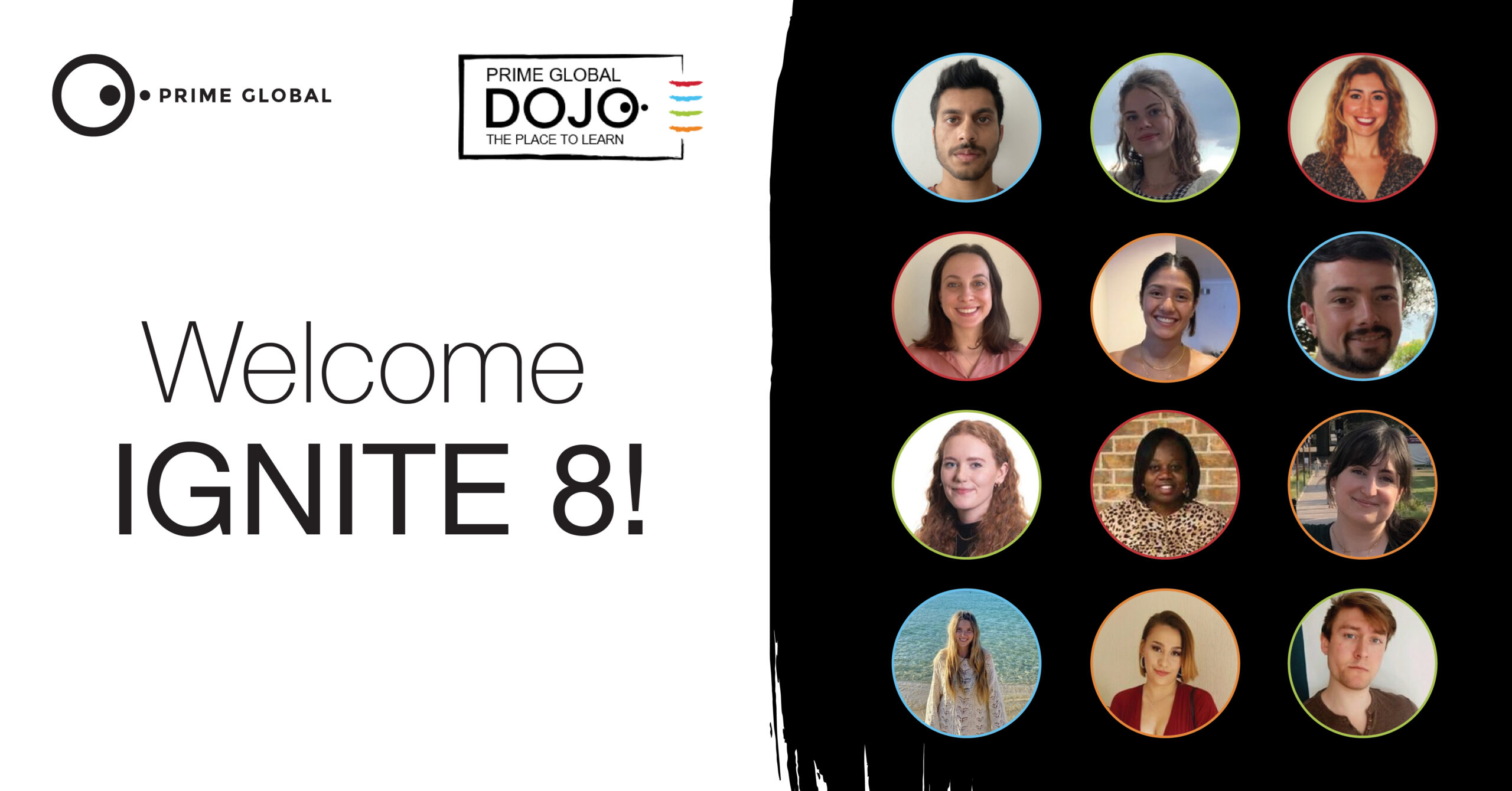Prime Patient collaborate with award-winning advocate Trishna Bharadia to explore how industry can better engage with people living with multiple sclerosis (PwMS) this MS Awareness Month.
Multiple sclerosis is an incurable autoimmune condition affecting the nervous system, and is characterised by symptoms such as fatigue and difficulty walking.(1) Although treatments are available and every PwMS is different and experiences MS in their own way, for some PwMS, their often-hidden disability can result in a major impact on quality of life, for example due to resulting unemployment and/or cognitive impairment.(2)
Since being diagnosed with MS in 2008, Trishna Bharadia has worked extensively with industry to improve the lives of people living with MS, with an impressive background including consultancy and public speaking. Despite positive initiatives from industry such as Biogen’s support of an MS study including patient-reported outcomes (a key way of embedding the patient voice into research) and the development of a huge number of MS-specific digital support offerings and apps, naturally, pharmaceutical companies haven’t always got it exactly right when setting out to work with PwMS. Fortunately, thanks to advocates like Trishna sharing their experiences and recommendations, there is a clear path for industry to move forward with justifiably enhanced confidence in engaging appropriately with this community.
PwMS from all communities must be actively embraced
A big priority for Trishna is championing diversity in patient advocacy, something which is gaining increased attention and prioritisation in Pharma. Trishna tells us “Pharma needs to ‘dive deeper’ into what diversity means in the context of PwMS in order to engage with a more diverse set of voices, e.g., regarding race/ethnicity, age, different types of MS, different levels of disability, gender, and more.”
As well as ensuring fair representation of views and experiences across different groups, active facilitation of diversity is critical for the generation of data that are reflective of PwMS ‘in the real world’. For example, MS has traditionally (and incorrectly) been considered a Caucasian condition, and there is therefore a lack of available data regarding how MS and MS treatments might affect people from different racial heritages. As a British Asian woman living with MS, Trishna is frustrated by not knowing how many other people like her there are in the UK; not only is this kind of scenario alienating, but it also makes it much harder to advocate for (or even identify) subpopulation-specific needs.
In order to elucidate characteristics and needs specific to different sub-populations of PwMS, it is necessary to conduct research. However, cultural barriers experienced in some communities can impede participation in such initiatives, and PwMS can feel a disconnect between good intentions in Pharma and how engagement initiatives are experienced by the MS community. Trishna explains that in Asian communities, disability and chronic illness can be met with serious stigma, with Trishna herself having been told by other Asians that her MS is somehow her fault, a result of karma or punishment from God for having done something bad in a former life. Experiences like this can lead PwMS to feel as if they must hide their MS or lie about why they are unwell. For Pharma, this shame and concealment could significantly hinder recruitment to clinical trials or engagement projects from these communities, further perpetuating knowledge gaps and healthcare inequities. Indeed, if PwMS who experience cultural barriers are not represented in research and engagement, it is unlikely the presence of these PwMS will become normalised enough to reduce the stigma currently experienced. Pharmaceutical companies therefore have an opportunity to make a social as well as medical impact on the lives of PwMS through the active facilitation of racial/ethnic diversity in study recruitment and publication of data specific to each community.

In the interests of inclusivity, it’s important for Pharma project teams to create an environment where representatives (e.g., PwMS) feel comfortable – and a relatively easy place to start is with the words used. Trishna explains “There are specific terms in the MS community that are disliked, such as ‘sufferer’, ‘wheelchair bound’, and ‘patient’, but I still see them being used by Pharma. More thought needs to be given to inclusive and considerate language that doesn’t alienate the PwMS Pharma is trying to engage with.” Trishna touches on something particularly important here – the fact that the importance of inclusive language goes both ways. For PwMS, unfortunate language choices could lead to feeling awkward, patronised, and disempowered and therefore less inclined to work with industry. For pharmaceutical companies, such sentiments could impact partnerships with PwMS and mean the difference between gaining insights to inform effective products and services and missing out on those opportunities.
To become familiar with which terms are preferred, pharmaceutical companies would do well to consult with patient organisations. For groups like this, preferred language is not only a part of their everyday lives, but also derived from the experiences and views of many PwMS, reducing the chance of companies running with terms which are perhaps comfortable for some PwMS but not the majority.
Adapting to the needs of individuals
 On the level of engaging with individual PwMS, Trishna’s advice to Pharma is to recognise the importance of regularly asking each participant of every project “how can we make this work for you?”. As Trishna describes, “MS can be a fluctuating condition day-to-day, week-to-week, month-to-month. What might be comfortable and possible at one point may not be as easy at another time. We can’t assume that someone will always be able to do what they’ve done in the past in the same way.” It’s easy for even the most well-meaning project teams to underestimate the reality of living with MS, but fortunately, there are some straightforward ways to ensure PwMS are accommodated for, even if project teams are unfamiliar with the condition.
On the level of engaging with individual PwMS, Trishna’s advice to Pharma is to recognise the importance of regularly asking each participant of every project “how can we make this work for you?”. As Trishna describes, “MS can be a fluctuating condition day-to-day, week-to-week, month-to-month. What might be comfortable and possible at one point may not be as easy at another time. We can’t assume that someone will always be able to do what they’ve done in the past in the same way.” It’s easy for even the most well-meaning project teams to underestimate the reality of living with MS, but fortunately, there are some straightforward ways to ensure PwMS are accommodated for, even if project teams are unfamiliar with the condition.
Meeting arrangements are a key example of where good efforts are seen, but could be enhanced further; a break (or multiple) in meetings or advisory board sessions can make collaborating with industry easier for PwMS, but as Trishna explains, the breaks offered are usually too short to fully account for the needs brought by living with MS. A typical five- to ten-minute “comfort break” may be enough for the average person to whizz to the bathroom or refuel with a snack, but for PwMS, mobility issues are one factor that can significantly increase the time required to complete such actions.
 When managing timelines for projects involving PwMS, it’s important to maintain perspective and compassion amidst the fast-paced culture and drilled-in processes we come to adapt to when working in or with industry. Trishna tells us that reasonable deadlines may well differ for each PwMS or depending on the day due to variations in fatigue, cognition, dexterity, and/or pain. What’s more, it is important to remember that sharing timelines early on is not a guarantee that PwMS will be able to commit to the deadlines set, as what is achievable on one day may be very different from what is feasible the next. Therefore, project managers must be flexible when planning and managing timelines in order to not only adapt to each PwMS’ initial estimations of what is feasible, but also to the possibility that these estimations may change over time.
When managing timelines for projects involving PwMS, it’s important to maintain perspective and compassion amidst the fast-paced culture and drilled-in processes we come to adapt to when working in or with industry. Trishna tells us that reasonable deadlines may well differ for each PwMS or depending on the day due to variations in fatigue, cognition, dexterity, and/or pain. What’s more, it is important to remember that sharing timelines early on is not a guarantee that PwMS will be able to commit to the deadlines set, as what is achievable on one day may be very different from what is feasible the next. Therefore, project managers must be flexible when planning and managing timelines in order to not only adapt to each PwMS’ initial estimations of what is feasible, but also to the possibility that these estimations may change over time.
Conclusion
Multiple sclerosis is highly variable and can pose significant challenges. However, with the right practices in place, companies can enjoy richer insights from people with lived experience of the condition and PwMS can enjoy a greater number of fair opportunities to have their voices heard and steer us all towards a brighter future.




